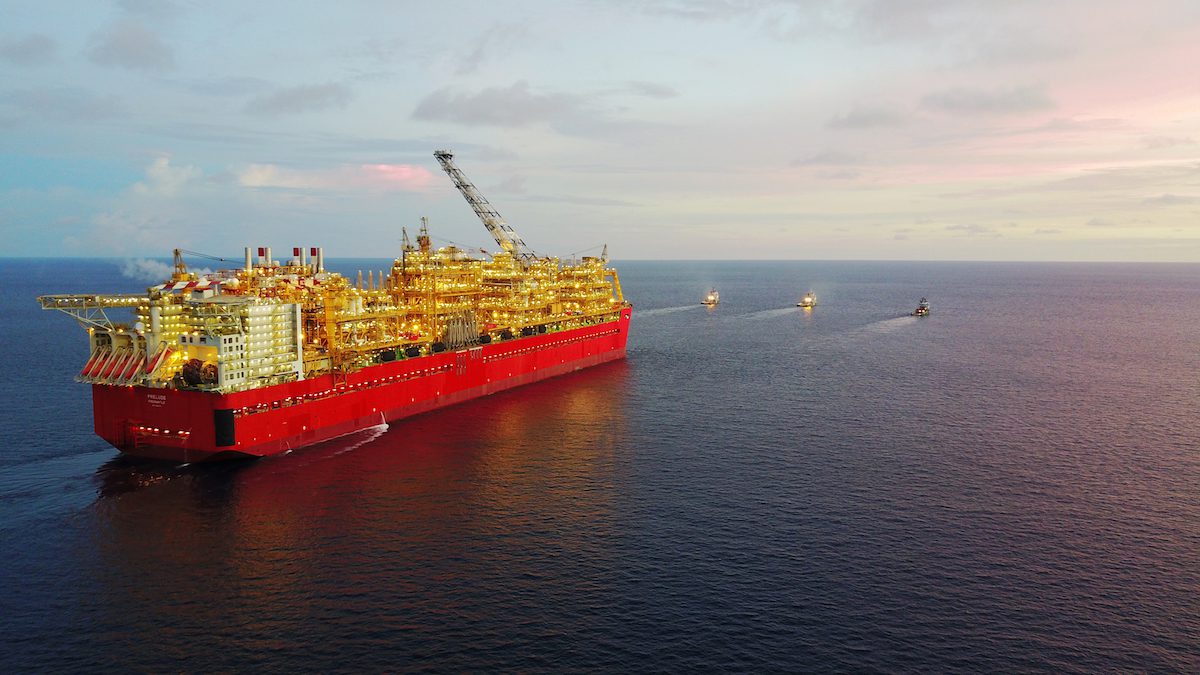Shell’s Prelude FLNG heads for Australia. Credit: Shell Australia
By Dan Murtaugh and Stephen Stapczynski (Bloomberg) — And then there was one.
Australia’s nine-year, $200 billion boom in liquefied natural gas still has a final debut in the works: Royal Dutch Shell Plc’s Prelude, floating 200 kilometers (124 miles) off its northwest coast. It’s the last project in that investment cycle to start production after Japan’s Inpex Corp. shipped its maiden cargo from Ichthys LNG on Monday.
Shell’s Prelude is among seven export projects in gas-rich Australia sanctioned since 2009 by global energy giants including Chevron Corp. and Exxon Mobil Corp., as well as regional big hitters such as Australia’s Woodside Petroleum Ltd. and Malaysia’s Petroleum Nasional Bhd. The Pacific nation now rivals Qatar as the world’s biggest seller of LNG, a form of natural gas super-chilled into a liquid that can be shipped on tankers.
The market might not have to wait long before Prelude gets in the game. It received a second cool-down cargo two weeks ago, a possible indication that workers are preparing equipment for start-up. Korea Gas Corp., a minority owner in the venture, said in August the plant would be in full commercial production by the end of December. Shell, which said as recently as July that the project is on target to start this year, declined to comment as it’s in a quiet period before it reports third-quarter earnings.
Unlike other LNG projects during the Australian boom, Prelude wasn’t built on solid ground. Instead, all of the equipment — from power generation to gas processing to liquefaction — is housed on a floating platform the size of six aircraft carriers connected to wells 250 meters below the surface of the Indian Ocean.
Scale, Complexity
“The scale of this, and the complexity of this — there is no other comparable project,” said Neil Beveridge, an analyst with Sanford C. Bernstein & Co. in Hong Kong. “When you do it at this kind of scale, the difficulties just become so much greater.”
At one point, Prelude was seen as the first of a fleet of floating LNG plants in Australia. Building in a controlled environment like a shipyard in South Korea was seen as avoiding the sort of cost overruns that plagued projects fighting for labor and resources on land in Australia. But ventures such as Woodside’s Browse and Sunrise, as well as Scarborough, which once counted Exxon among its backers, have been re-imagined on land because of economic or political concerns. None of those are yet to take a final investment decision.
Shell owns 67.5 percent of Prelude while Inpex, which is also the operator of Ichthys LNG, holds 17.5 percent. (Beyond the Inpex connection, the Prelude and Ichthys project may also share gas at a reservoir called Brewster.) Korea Gas has 10 percent and Taiwan’s CPC Corp. owns the remaining 5 percent.
© 2018 Bloomberg L.P
Unlock Exclusive Insights Today!
Join the gCaptain Club for curated content, insider opinions, and vibrant community discussions.

 Join The Club
Join The Club













